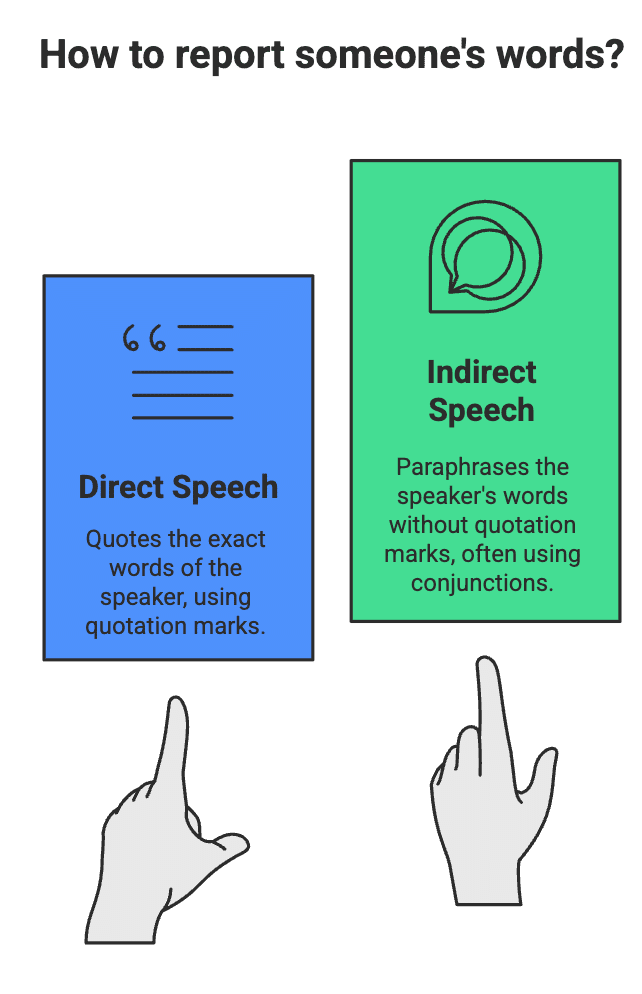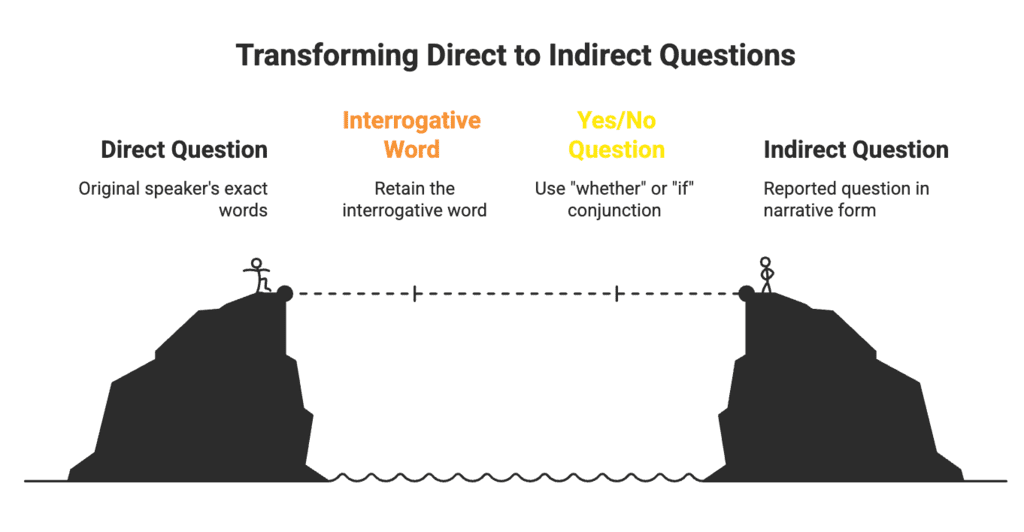Wren and Martin Summary: Direct & Indirect Speech | Verbal Ability & Reading Comprehension (VARC) - CAT PDF Download
Introduction to Direct and Indirect Speech
Direct and Indirect Speech are two ways to report what someone has said.
Direct Speech: Quotes the exact words of the speaker, using quotation marks (inverted commas).
Example: Rama said, "I am very busy now."Indirect Speech (Reported Speech): Paraphrases the speaker’s words without quoting them exactly, and no quotation marks are used.
Example: Rama said that he was very busy then.
Key Observations:
In Indirect Speech, a conjunction like "that" is often used (though it can be omitted in spoken English).
Changes occur in pronouns, verbs, and adverbs when converting from Direct to Indirect Speech.

Rules for Changing Direct Speech to Indirect Speech
When converting Direct Speech to Indirect Speech, specific changes are made based on the tense of the reporting verb and other factors.
Changes When Reporting Verb is in Past Tense
If the reporting verb (e.g., "said") is in the past tense, the tenses in the Direct Speech shift to corresponding past tenses:
Simple Present → Simple Past
Direct: He said, "I am unwell."
Indirect: He said that he was unwell.Present Continuous → Past Continuous
Direct: He said, "My master is writing letters."
Indirect: He said that his master was writing letters.Present Perfect → Past Perfect
Direct: He said, "I have passed the examination."
Indirect: He said that he had passed the examination.Simple Past → Past Perfect
Direct: He said, "The horse died in the night."
Indirect: He said that the horse had died in the night.Future Tense:
"Shall" → "Should"
"Will" → "Would" or "Should"
Example: Direct: She said, "I will help you."
Indirect: She said that she would help him.
Exception: If the statement is a universal truth or still relevant, the tense may remain unchanged.
Example:
Direct: The teacher said, "The Earth goes round the sun."
Indirect: The teacher said the Earth goes/went around the sun.
No Tense Change When Reporting Verb is in Present Tense
If the reporting verb is in the present tense (e.g., "says"), the tenses in the Direct Speech remain unchanged.
Examples:
Direct: He says, "I am unwell."
Indirect: He says he is unwell.Direct: He says, "I have passed the examination."
Indirect: He says he has passed the examination.
Pronoun Changes
Pronouns change to reflect the perspective of the reporter, not the original speaker.
Examples:
Direct: He said to me, "I don’t believe you."
Indirect: He said he didn’t believe me.Direct: She said to him, "I don’t believe you."
Indirect: She said she didn’t believe him.
Changes in Time and Place Words
Words indicating nearness in time or place are changed to words indicating distance:
now → then
today → that day
here → there
tomorrow → the next day
yesterday → the day before
ago → before
this → that
these → those
Example:
Direct: He says, "I am glad to be here this evening."
Indirect: He says that he was glad to be there that evening.
Exception: No change occurs if the speech is reported at the same time or place.
Example:
Direct: He said, "I am glad to be here this evening."
Indirect: He said he is glad to be here this evening.
Reporting Questions
Questions in Indirect Speech are introduced by verbs like "asked" or "inquired."
If the question uses an interrogative word (e.g., what, where, why), it is retained.
Example:
Direct: He said to me, "What are you doing?"
Indirect: He asked me what I was doing.If the question is a yes/no question, "whether" or "if" is used.
Example:
Direct: He said, "Will you listen to such a man?"
Indirect: He asked them whether they would listen to such a man.

Reporting Commands and Requests
In English, commands and requests are statements where the speaker tells someone to do something. When converting these from Direct Speech to Indirect Speech, specific rules are followed to reflect the speaker’s intent accurately. The explanation below breaks down the rule you provided, with clear explanations and examples.
Key Rule:
- Commands and requests in Direct Speech are reported in Indirect Speech using verbs like "ordered," "requested," or "urged."
- The imperative mood (the verb form used for commands, e.g., "Go," "Sit," "Please wait") is changed into the infinitive form (to + verb, e.g., "to go," "to sit," "to wait").
What is the Imperative Mood?
The imperative mood is used to give orders, instructions, or requests. It typically does not include a subject (the subject "you" is implied) and uses the base form of the verb.
- Example of a command: "Go away."
- Example of a request: "Please wait here."
Examples of direct to indirect speech:
Direct: Rama said to Arjun, "Go away."
Indirect: Rama ordered Arjun to go away.Direct: He said to him, "Please wait here till I return."
Indirect: He requested him to wait there till he returned.
Reporting Exclamations and Wishes
Exclamations and wishes are introduced by verbs like "exclaimed," "applauded," or "prayed," and the emotion is described.
Examples:
Direct: He said, "Alas! I am undone."
Indirect: He exclaimed sadly that he was undone.Direct: He said, "Bravo! You have done well."
Indirect: He applauded him, saying that he had done well.
Converting Indirect Speech to Direct Speech
To convert Indirect Speech to Direct Speech:
Restore the original tense of the verb.
Change pronouns to reflect the original speaker’s perspective.
Use quotation marks and restore the original time/place.
Some examples:
Example 1: Statement (Universal Truth)
Indirect: The teacher said that the sun rises in the east.
Direct: The teacher said, "The sun rises in the east."
Explanation:
- The verb "rises" remains unchanged because it’s a universal truth, so no tense shift is needed.
- No pronoun changes are required, as the statement is general.
- Quotation marks are added to show the exact words.
- The reporting verb "said" is retained.
Example 2: Yes/No Question
Indirect: She asked him if he was coming to the party.
Direct: She said to him, "Are you coming to the party?"
Explanation:
- The verb "was coming" (past continuous) is restored to "are coming" (present continuous).
- The pronoun "he" becomes "you" to reflect the original listener.
- The word "if" is removed, and the question structure is restored with the auxiliary verb "Are" at the start.
- Quotation marks are added, and the reporting verb "asked" becomes "said to him."
Example 3: Command (Negative)
Indirect: The teacher told the students not to talk during the exam.
Direct: The teacher said to the students, "Don’t talk during the exam."
Explanation:
- The infinitive "not to talk" is restored to the negative imperative "Don’t talk."
- The pronoun "the students" becomes the implied "you" in the imperative, addressed as "to the students."
- The reporting verb "told" is simplified to "said to the students."
- Quotation marks are added.
Example 4: Exclamation (Expressing Surprise)
Indirect: She exclaimed that it was a beautiful view.
Direct: She said, "What a beautiful view!"
Explanation:
- The verb "was" is restored to "is" to reflect the original tense.
- The pronoun "she" becomes "I" (implied in the exclamation).
- The exclamation structure is restored with "What a" to express surprise.
- Quotation marks are added, and "exclaimed" is simplified to "said."
Example 5: Wish
Indirect: He wished that he could fly like a bird.
Direct: He said, "I wish I could fly like a bird."
Explanation:
- The verb "could fly" remains unchanged, as it’s already in the subjunctive mood used for wishes.
- The pronoun "he" becomes "I" to reflect the original speaker.
- The phrase "I wish" is restored to make the wish explicit.
- Quotation marks are added, and "wished" is simplified to "said."
Examples of Direct to Indirect Speech
Note: The tense of reported speech may not change if reported speech is a universal truth, though its reporting verb belongs to the past tense.
|
184 videos|572 docs|126 tests
|
FAQs on Wren and Martin Summary: Direct & Indirect Speech - Verbal Ability & Reading Comprehension (VARC) - CAT
| 1. What are the rules for a change of speech? |  |
| 2. Can you provide an example of a change of speech using direct speech? |  |
| 3. How do you change speech from direct to indirect when the reporting verb is in the present tense? |  |
| 4. What is the importance of using quotation marks in a change of speech? |  |
| 5. Can you provide an example of a change of speech using indirect speech? |  |

















